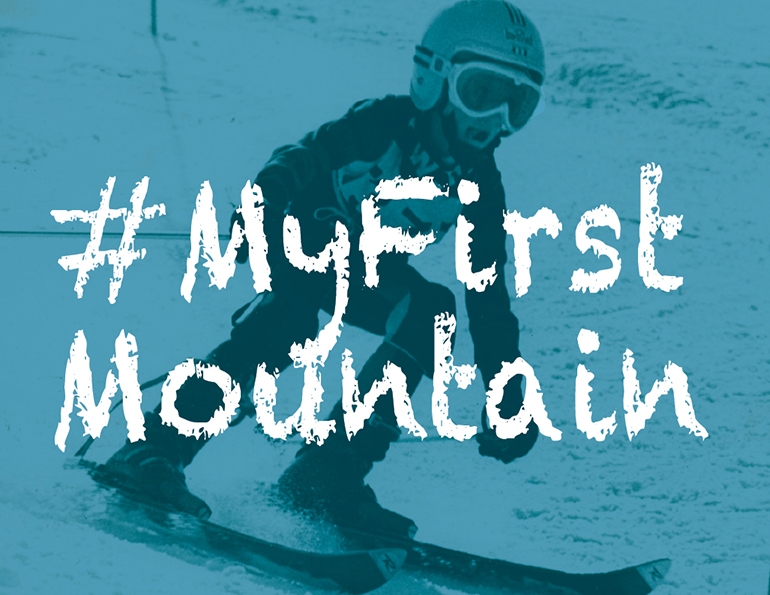In this age of multi-billion-dollar conglomerates and $180 lift tickets, there is a breed of ski areas that tends to fly under the radar: non-profit ski areas. But in many cases these areas are thriving, and serve a critical role in maintaining the popularity of snowsports in North America.
They come in all shapes and sizes, from Bridger Bowl’s 2,000 skiable acres and 2,700 feet of vertical to North Dakota’s Frost Fire and its terrain park, beginner trail, and tubing hill. Some, like Bridger, have operated as non-profits for decades. Others, like Frost Fire, recently adopted the structure as a means of survival.
Here, in the first of a series about community ski areas, we share the stories of three non-profits that play vital roles in their communities, both now and in the future.
TAWATINAW VALLEY
On a crisp November evening in 2017 in Westlock County, Alberta, a group of passionate and stunned local skiers gathered in the parking lot. Citing expenses that ran a steep deficit, county officials had just narrowly voted to close the Tawatinaw Valley Ski Area, a beloved community resource and gathering spot.
The dedicated locals huddled and decided, “We wanted to save it. We wanted to find a way to keep it open,” says Heather Toporowski, secretary of the non-profit that now runs it. “We realized if we wanted it, we had to do it.”
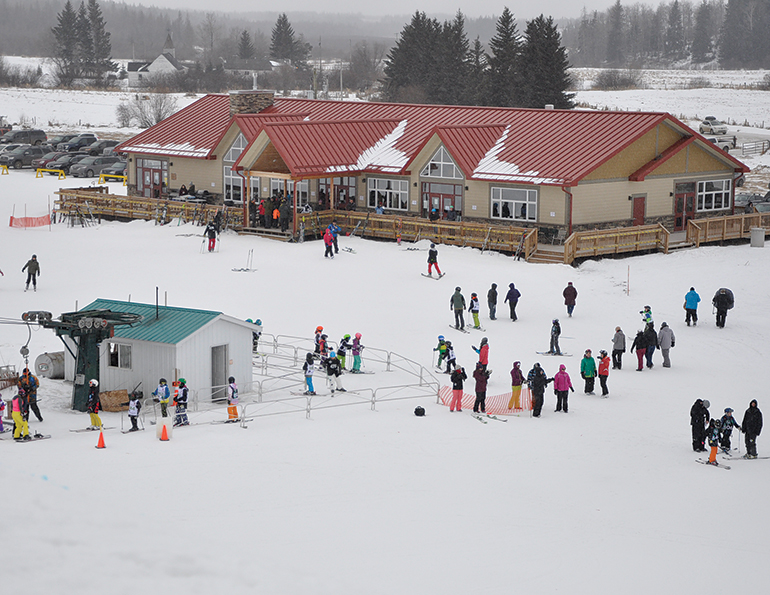 Tawatinaw Valley’s bustling base area.
Tawatinaw Valley’s bustling base area.
Soon, that parking lot group helped form the Friends of the Tawatinaw Working Group (FTWG). The goal was to take over the hill and operate it as a non-profit, which would require well over $1.5 million annually to run. Last fall, a new slate of county leaders agreed to support the hill financially on a decreasing scale, with FTWG running it as an independent non-profit at the end of three years.
Now, Tawatinaw Valley—founded more than 40 years ago as part of Canada’s Centennial Project—is poised for a revitalization under its new management. “It’s been a real rocket ride,” says Toporowski.
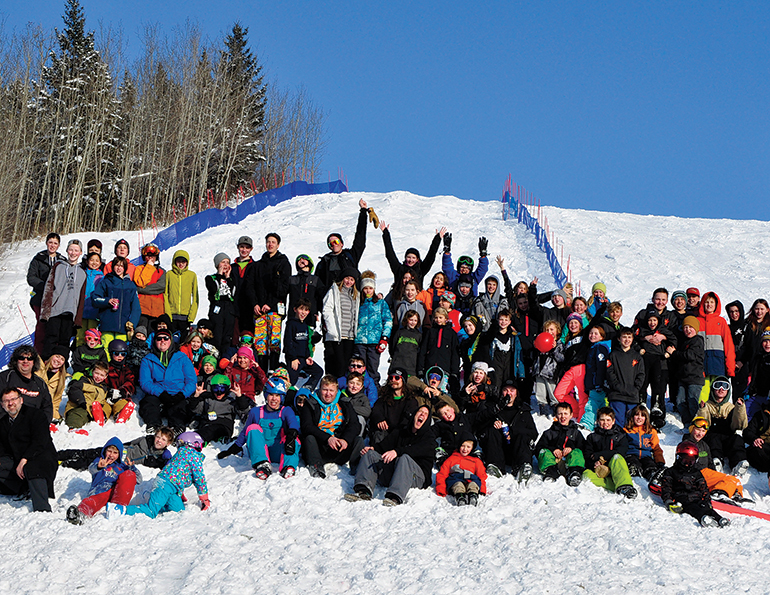 A club competition at Tawatinaw Valley.
A club competition at Tawatinaw Valley.
With that, Tawatinaw Valley Ski Area joins the ranks of North America’s not-for-profit ski areas, of which there are dozens.
What makes for an ideal non-profit ski area? The confluence of location, history, strong volunteers who understand the industry, and a community’s sense of ownership top the list.
In Westlock County, all that is visible. “Living in a rural area, all we see is us gradually losing the things that make us a community,” Toporowski says. “Our local school closed, businesses close. The hill was like a symbol: Our rural community that we love was starting to wither away. This was a way we could stop that.”
It’s a team effort. “We thought we would be an advisory board on steroids, and here we are operating a ski hill,” says Toporowski, who volunteers nearly full time. She gives much credit to FTWG’s president, Wendy Batog, a heavy equipment appraiser of whom Toporowski says, “There is nothing she doesn't know about machinery. She has single-handedly ensured everything mechanical is running in perfect condition, from lifts to kitchen equipment, via her knowledge and contacts. Her energy just pulls us along.”
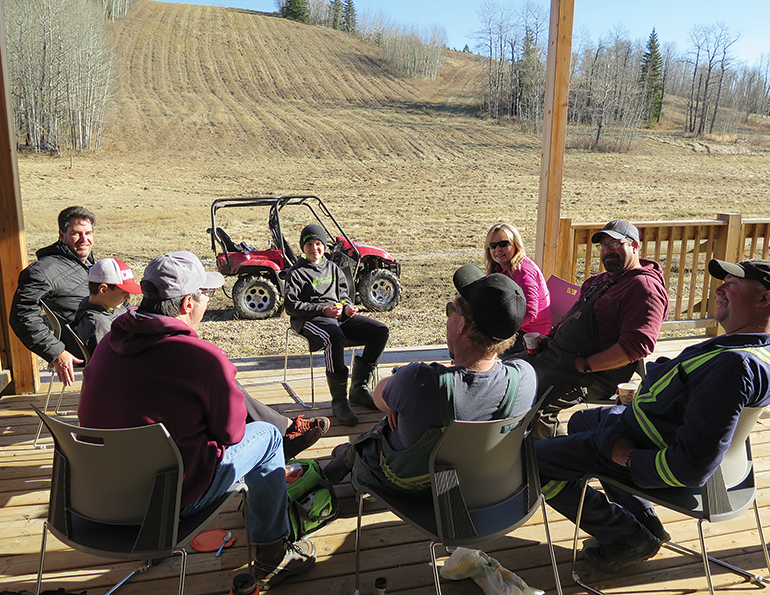 An FTWG meeting at the hill.
An FTWG meeting at the hill.
“Us” is a team of many dozens of volunteers, who “are all passionate users who understand what it takes to run a ski resort,” she says.
And the community has rallied. More than 125 people attended the council meeting to help sway the county vote to yes, and in the weeks leading up to this ski season, dozens cleared trails, painted rooms, got chairlifts ready, and mowed grass. The Rotary Club funded the entire purchase of needed rental equipment. A local group called “100 Women Who Care” bought the rental helmets. Three local car dealerships purchased all the tubes for tubing, and Servus Alberta, a local bank, is funding free tubing for families every Sunday.
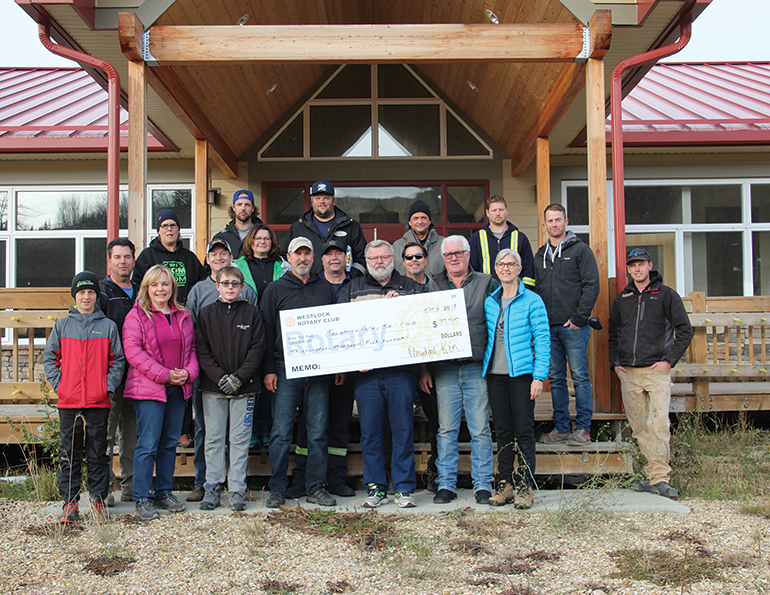 Westlock Rotary Club presents a $75,000 check to purchase rental equipment.
Westlock Rotary Club presents a $75,000 check to purchase rental equipment.
Toporowski and her board are also looking toward year-round, revenue-producing operations, envisioning yoga retreats and other active mountain programs. For more ideas, they’ll turn to the community. “We really want to hear what people feel we need,” she says.
And Toporowski hears the praise. “Everywhere I go, people say, ‘Thank you for saving this,’” she says. “Even at my niece’s wedding, it was the talk of the night. People are pleased.”
MT. ASHLAND
Oregon’s Mt. Ashland has been operating as a strong non-profit since 1992. And according to general manager Hiram Towle, there are times when being a non-profit can actually benefit a resort.
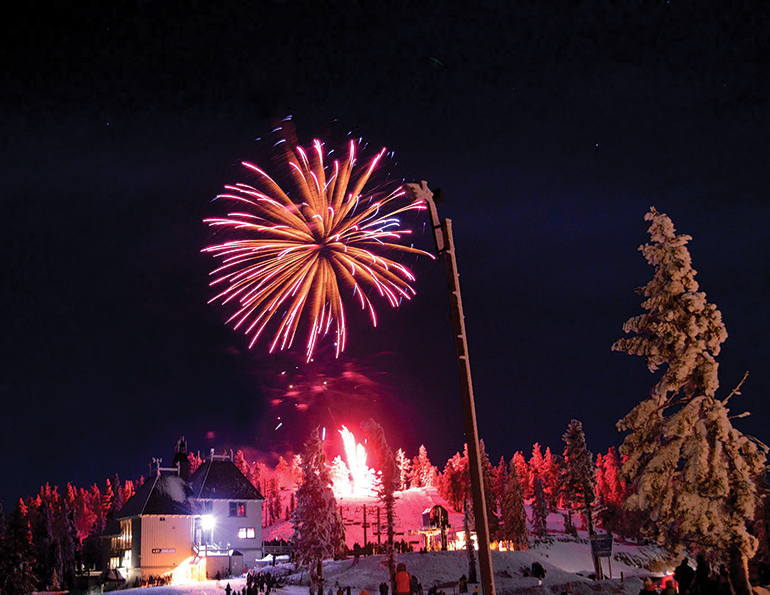 At Mt. Ashland, fireworks light up the sky.
At Mt. Ashland, fireworks light up the sky.
“We have the same challenges as for-profit small areas,” Towle says. “Climate change. Insurance costs escalating. Finding employees who can work for minimum wage.” The beauty of being a non-profit, he says, is simple: the ability to fundraise. And the community plays a major role in that.
For instance, when Mt. Ashland wasn’t able to open for a single day in the dry 2013-14 season, that put the mountain in a tough spot. Instead of providing refunds to season passholders, Ashland gave them the option to return their passes as tax-deductible donations to the area, and most did. This is an option for-profit areas just don’t have.
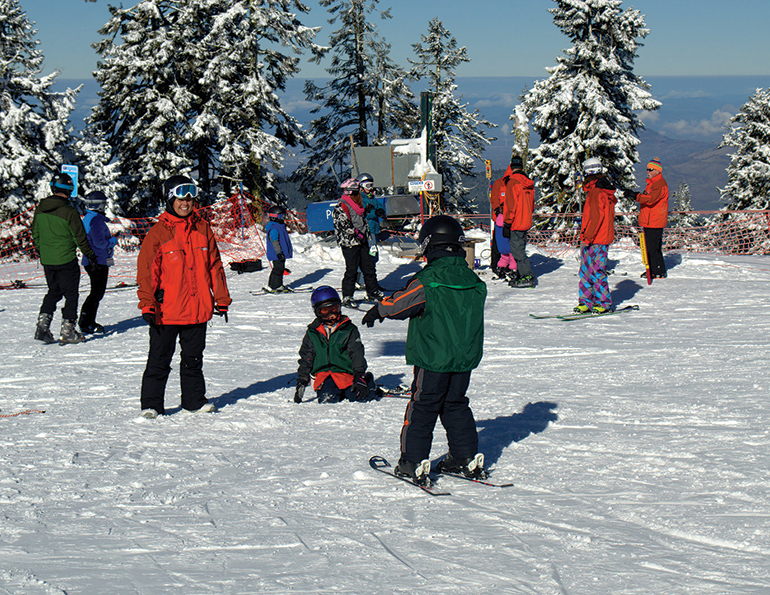 Kids learn to enjoy the outdoors.
Kids learn to enjoy the outdoors.
“We have a supportive and loyal community,” Towle gushes. “One that sees this as a community asset they always want to support.” And it shows. In the past year, Ashland needed $1.7 million for lodge renovations, and a whopping $1.4 million was raised right in its own community, with one $500,000 matching grant and some other large donations. And they’ll be asking for more. “Our lifts are getting old and we need more parking,” says Towle.
The community takes action when the mountain needs help, and the return on investment is strong. “We have no lift lines and our slopes are never crowded,” says Towle. “We have a separate learning hill for beginners, and a glacial bowl with lift-serviced steeps. Where else can you find that on 220 skiable acres?”
But it goes deeper than that.
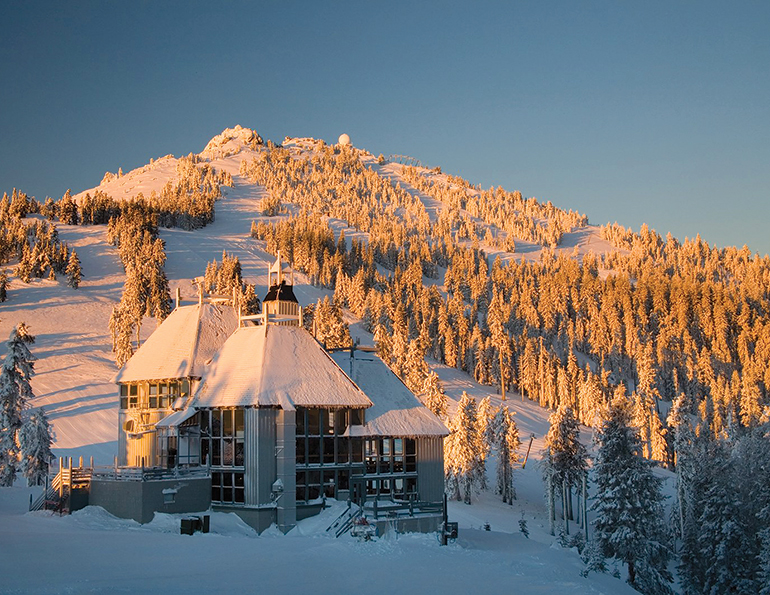 Beauty is a strong part of the community’s ROI.
Beauty is a strong part of the community’s ROI.
“We call this the ‘XBox antidote,’” he says. “It is our mission—and the community’s— to get kids up here and help them learn how to have fun outside. We trick them away from the screen and into healthy living.
“And it’s a great family atmosphere out here. A lot of people know each other well, but only on the ski hill. It’s like they head up here and they are all family.”
ANTELOPE BUTTE
Antelope Butte Ski Area in Wyoming was a community centerpiece for nearly 60 years before it ceased operation in 2004. As residents mourned, it sat dormant through a bankruptcy case and a failed purchase attempt to become a boy’s camp, and then, it faced demolition.
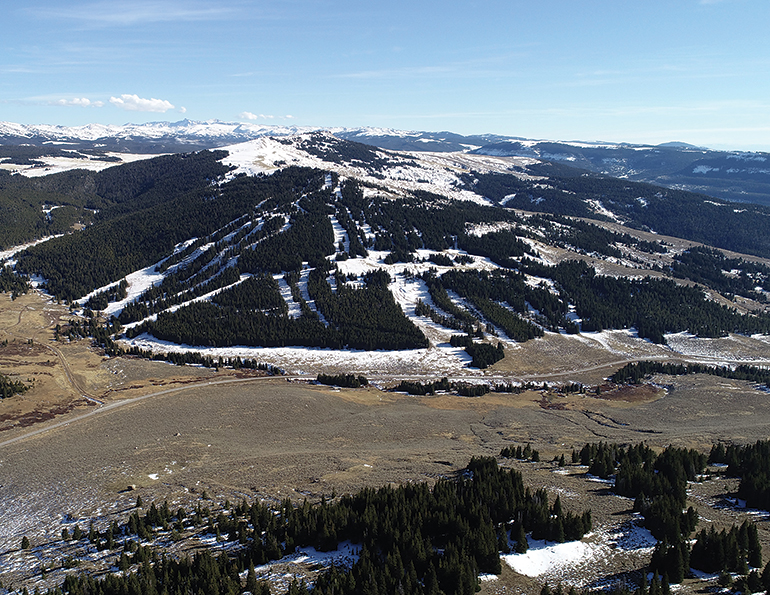 The treasure that is Antelope Butte.
The treasure that is Antelope Butte.
It was the threat of demolition that spurred loyalists into action. Today, the Antelope Butte Foundation (ABF) is ready to open winter sports operations again this winter, and has plans to become a year-round community recreation hub.
ABF formed in 2011, received 501(c)3 non-profit status in 2014, and officially purchased the ski area in 2016—with some huge challenges to overcome: The lifts had been sold, base lodge vandalized, and most of the operating equipment stripped from the site.
The mountain was purchased for $250,000, raised entirely through donations from individuals and foundations.
“The first thing we had to do was ask ourselves: can this be saved?” recalls John Kirlin, ABF executive director. Once they confirmed that damage to the main building was superficial, the resurrection was on, and the real work began.
ABF created what Kirlin calls a “well crafted capital plan” that included the lodge repairs, lift rebuilding, and more. The community has responded, and while ABF still has more fundraising to do—and always will—the area is poised to open for skiing and riding, with limited operations in the base lodge to start. “We have a really great group of donors and supporters,” says Kirlin. “We need more. We’re still actively fundraising, but we feel confident.”
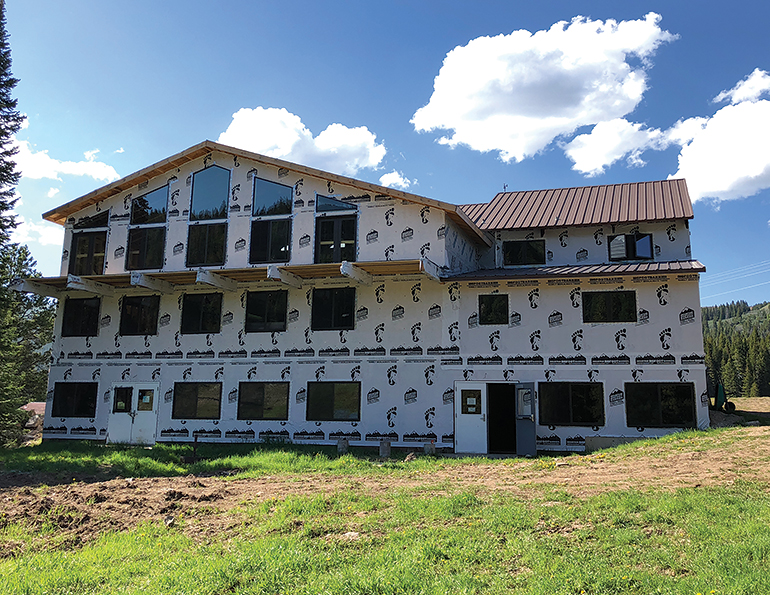 The renovated base lodge was key to reopening.
The renovated base lodge was key to reopening.
So, why go through all this work to save the 250-acre hill? “More like, why not?" says Kirlin. "Because it’s awesome. Because it’s beautiful. And because it means a lot to the community. People love the idea of it being their backyard hill. It’s a place you can go and learn and expand your learning. It’s affordable and close. It’s all about the community. That’s what we’re striving for: a community spot.”
ABF had a little luck go its way early on, too, when the federal government passed the Ski Area Recreational Opportunity Act of 2011. The Act expanded the list of allowed activities on permitted Forest Service lands (Antelope Butte operates in Big Horn National Forest), such as zip lines, ropes courses, and bike parks. So Kirlin and his team can work toward year round operations.
“That’s going to be a game changer for us,” says Kirlin. “Now we can buffer those difficult snow winters [with income from other seasons].” In the year-round vision, he says, “mountain biking will be big. The lodge is also a great venue for weddings, events, retreats, and a place to just go and be on the mountain.” He envisions summer music and brew festivals, as well as youth programs such as an intro to camping.
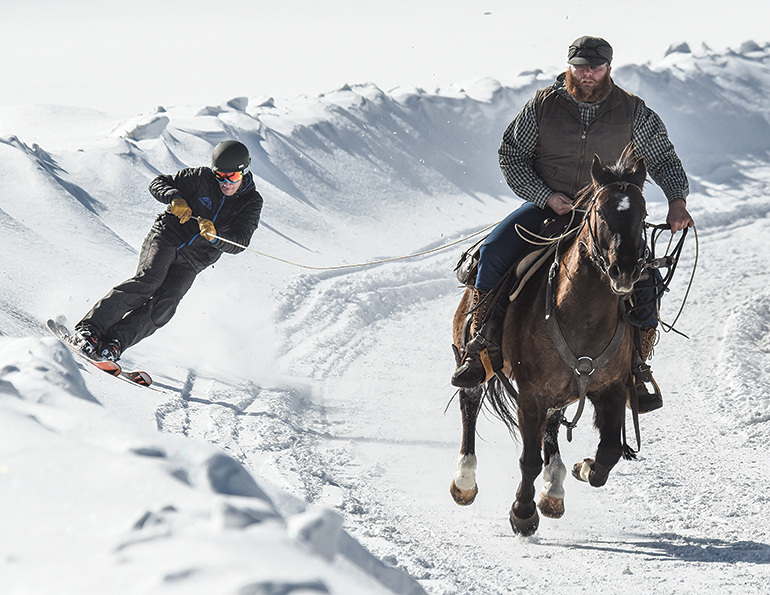 Winter fun, Wyoming style.
Winter fun, Wyoming style.
But the first major step will be opening for winter operations for the first time in 14 years. Some locals will be dusting off their skis and boards for the first time since Antelope Butte shut down—a testament to the importance of accessibility. “This place means so much to this community,” says Kirlin. “You know what’s really compelling? The stories. I think everyone around here has a story or more about time spent here.” And now, a new generation of stories is in the making.
THE LARGER COMMUNITY
Constance Beverley, CEO of Share Winter Foundation, a non-profit group that provides grants to non-profit ski areas as well as other skiing and riding programs, believes support from the mountain resort community is vital to everyone’s success.
“I would love it if the industry would support this,” says Beverley. “There is great value in these areas for everyone. The way they are bringing people into [skiing and riding] is important, and that funnel is going to benefit everyone. Investing in [non-profits] and partnering with them would be a really great thing for [larger resorts] to do.”
Beverley aims to expand the Share Winter Foundation’s reach exponentially. A key to that, she believes, is to show larger resorts the benefits of supporting her group, and non-profit hills in general. Right now, she says, they have zero financial support from the industry at large.
She’d love to see small changes first. For instance, small non-profits often pay full price for rental fleets, a huge expense. “Easing that financial burden could really change the pipeline,” she says.
Direct financial and logistical support to the small hills could be a turning point for the industry. “You read so much about ski areas struggling and the behemoths taking over,” she says. “[Small non-profit’s] refusal to give up is something our industry should celebrate. And support.”
She points out that larger resorts are not cruel or ungiving. Many have programs that help more people, namely kids, get into the sport for little to no cost. But more can be done, she says.
All three ski areas featured here say bigger resorts helped them out as they built their programs.
“We all thought they would see us as competition, but that was not the case at all,” says Toporowski. “They’ve been awesome,” she says of nearby resorts like Snow Valley, Sun Ridge, and Rabbit Hill. “Their staffs come to help us, they share their manuals and knowledge, and are just so, so generous. We feel like we’ve been embraced by the ski community.”
Antelope Butte has benefited greatly from the council and support of one of the industry’s most respected leaders, Vail Resorts senior advisor Blaise Carrig. “He has shared so much knowledge and also is a donor,” Kirlin says. Beverley believes more of that on an official basis will boost the industry as a whole.
Truth be told, maintaining a positive money flow at a non-profit ski area is hard, hard work. But so, too, says Towle, is operating a small ski area in general. “We run like a frugal Yankee,” he says. “And even then, it’s tight every year. That’s the reality of this industry.”
Beverley believes it is crucial work, hard as it may be. “These areas are the lifeblood of the industry. When you become a skier or snowboarder, you become part of the community—the tribe. And at small areas, that feeling comes fast. We have to preserve that. It’s the best way to welcome people into this world for good.”
And oh: the joy. Toporowski still cannot believe her parking lot group pulled this off. “It really is like a movie,” she says. “Sometimes we joke about who will play us in the film.”





